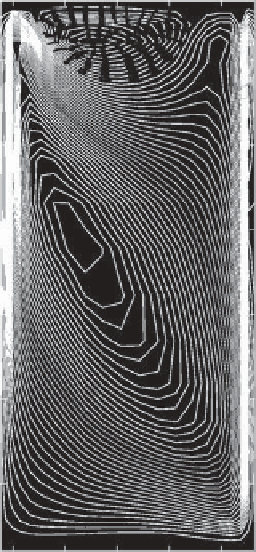Geoscience Reference
In-Depth Information
(a)
(b)
(c)
12
12
12
10
10
10
8
8
8
6
6
6
4
4
4
2
2
2
3
4
5
Radius (cm)
6
7
3
4
5
Radius (cm)
6
7
3
4
5
Radius (cm)
6
7
Figure 1.25.
Maps in the
(r
,
z)
plane of (a) the eddy-induced transport stream function
χ
q
derived from a parameterization based
on the zonal mean QG potential vorti
city f
field [
Treguier et al.
, 1997], (b) the corresponding parameterized radial eddy-induced
velocity (
u
=1
/r∂χ
q
/∂z
=
(
K
q
/f )∂(q
2
D
)/∂r
), and (c) radial eddy-induced velocity diagnosed from the fully 3D simulation
∗
−
(u
q
)/f
) as obtained by
Pérez
[2006]. Note the remarkable degree of resemblance between (b) and (c). In each case
negative values are shown with dashed contours.
(
u
=
∗
simulated zonal mean temperature field begins to appear
less obviously realistic, with apparent reversals of hor-
izontal thermal gradient in the geostrophic interior, for
example, that might reflect artifacts in the flow due to
inadequate spatial resolution in the model. This needs
to be investigated further in future work, which should
include proper verification of the heat transfer and flow
structure against laboratory measurements and the use of
a higher resolution model.
and time, the use of (often ad hoc) parameterization tech-
niques to represent unresolved scales of motion, especially
concerning the difficulty of accurately validating model
simulations against measurements (which generally have
incomplete and patchy coverage in space and time).
Laboratory studies help to focus attention on what fac-
tors may be fundamental to processes affecting the cli-
mate of an Earth-like planet, particularly under changing
parametric conditions, in contrast to factors that may be
incidental and/or specific to a particular system and may
therefore be generalized across whole classes of system.
The results presented above on quantifying heat transport
in the thermally driven annulus system provide a prime
example, in which we show how fundamental ideas on
how the efficiency of heat transfer by baroclinic eddies
appear to apply with equal validity both to laboratory
flow systems and in the oceans (and in atmospheres too)
provided the contribution to heat transfer in the labora-
tory due to the boundary layer circulation can be sepa-
rated from that due to the baroclinic eddies themselves.
This leads naturally to the use of laboratory experimental
1.5. DISCUSSION
In this chapter we have argued for the continued value
and utility of rotating annulus laboratory experiments
in the context of wider studies of the global circula-
tion of planetary atmospheres and oceans. Despite many
advances in the numerical modeling of atmospheres and
oceans in the past 30 years, such approaches still have
many limitations, particularly with regard to uncertain-
ties associated with the use of finite resolution in space


















